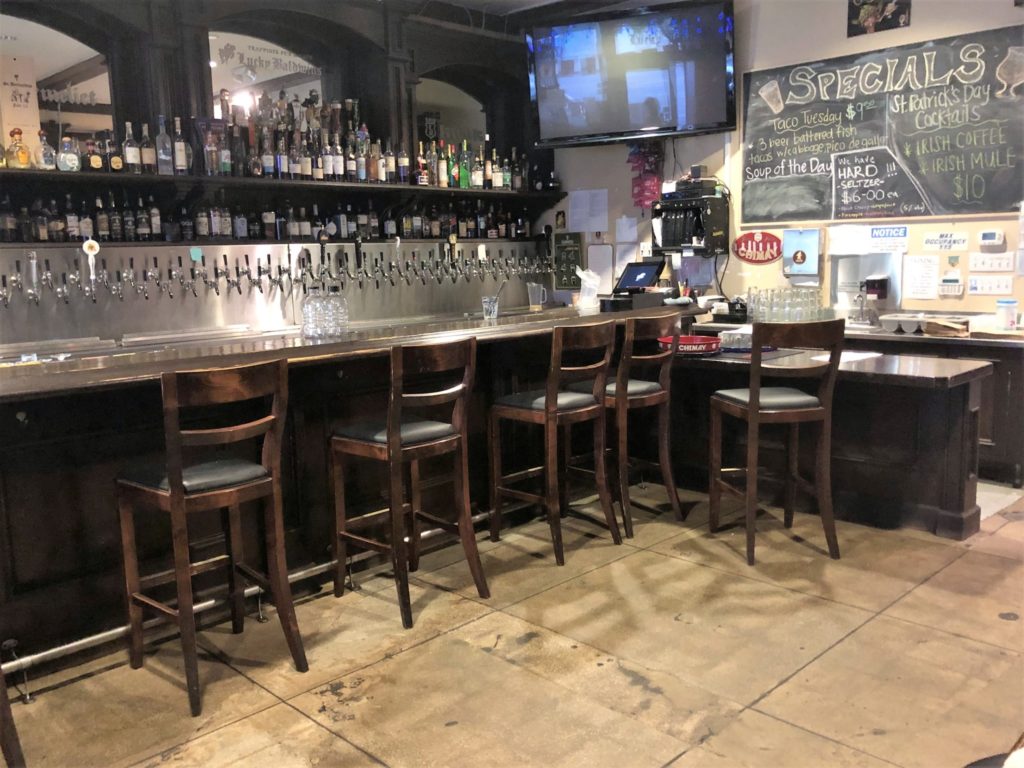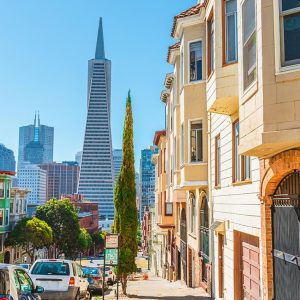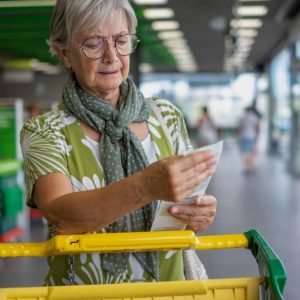 View Winners →
View Winners → The Restaurant Business Remains Challenging as Newsom Sets New Rules to Open


Lucky Baldwin’s bar remains empty, as do all bars in most states as a result of the coronavirus, COVID-19 pandemic. – Photo by Terry Miller / Beacon Media News
Modification of mandates could help reopen restaurants for dining in
By Terry Miller
Tuesday’s state press conference in Sacramento was soberly optimistic, to paraphrase Governor Gavin Newsom. He announced modifications to the statewide stay-at-home order to allow more businesses in California to reopen, including dine-in restaurants, shopping malls and offices.
Stressing that 70 percent of the state has at least partially reopened, Newsom stressed in no uncertain terms the importance of testing and contact tracing as the key figures in getting back to business. Newsom said that the figures of COVID-19 patients are showing signs of stability and stressed that the latest numbers are “encouraging.”
Stressing the importance of reduced capacity and social distancing for restaurants, Newsom said it is not a “one size fits all.” Every restaurant is different and flexibility in spacing is just one part of the state’s guidelines published in PDF form Tuesday.
So far only two counties, Butte and El Dorado, have met the state requirements to move further into phase 2 of reopenings.
In order to be ready to open for dine-in service, restaurants must adhere to the following, according to state guidelines:
- Have disposable menus or post menus online so diners can view them on their own devices.
- Cutlery, napkins and cups should not be “pre-set” on the table before diners sit down.
- Avoid use of shared condiments.
- Pre-roll utensils in napkins before giving them to customers.
- Takeout containers for leftovers must be filled by customers.
- Thoroughly clean tables, chairs, etc. after each group’s use.
- No table-side food preparation.
- Bar areas inside restaurants should stay closed.
Diners should also wear masks inside restaurants when they aren’t eating, the guidelines stress, plus many more suggestions to keep customers and staff safe.
Federal Government Struggles With Guidelines
Not everyone is as cautiously optimistic as Governor Newsom, including Dr. Anthony Fauci.
With President Trump pushing hard to reopen the country, Dr. Fauci, a key member of the White House’s coronavirus task force and director of the National Institute of Allergy and Infectious Diseases, warned senators Tuesday that states and cities face serious consequences if they open up too quickly, urging states not to reopen “until they know they have the capabilities to handle an inevitable uptick in cases once they relax stay-at-home orders,” according to a report on CNN.
“I see the new normal being what it was three months ago. I think we want to go back to where it was,” President Donald Trump said at a meeting with representatives from the restaurant and hospitality industries two weeks ago.
Behind the scenes, restaurant industry groups have been pressuring the administration to issue nationwide standards that won’t cost an arm and a leg.
In that same meeting, Trump appeared mindful that half-full restaurants and businesses wouldn’t provide a sense of normalcy.
“I had one restaurant owner come up to me and said, ‘Sir, you know I’m going to be opening up but if I distance too much I have 50 percent of the restaurant I had,’ ” Trump said. “I said, and you’ll also have a worse atmosphere,” according to a CNN report.

A long-time Lucky Baldwin’s server, Tatiana Fister, was one of those who lost her job in March. – Photo by Terry Miller / Beacon Media News
Local Restaurants Adapt
In California, restaurants and local chambers of commerce have been fighting hard for the county and state to relax the laws. According to the California Restaurant Association, 20 to 30 percent of all restaurants in the state might not survive the pandemic.
Additionally, the constantly changing guidelines and differing government levels have caused confusion and uncertainty among many restaurant owners.
Take one restaurant, for example, and see how many people it not only serves, employs and how that restaurant circulates the cash in the local economy.
We asked Peggy Simonian, the owner of the popular Lucky Baldwin’s Pubs in Pasadena and Sierra Madre, how her life has changed since the stay-at home mandate. It was obvious during our interview that the frustrations of running such a business before March 17 were already a challenge. But this added, unprecedented pandemic turned her world upside down.
Q: How are you coping with the new ‘normal’?
A: Yes, this has been a massive challenge for us all. It’s been really difficult to get to this point, and now that we’ve set up a path to work within, it’s all changed again.
There has been talk about opening up 50 percent capacity, disposable utensils (no different from takeout). Will it be disposable pints? Not sure. At this point there is so much change and so much talk that I try not to get too involved or even think about something that is not here yet. Just trying to deal with this day-by -day and try to live in the moment.
Q: What are the guidelines for opening up again?
A: Until I receive notification from the Health Department, as to what the guidelines are, only then can I see how I can adapt my business. At that point if the rules and regulations are so demanding of restaurants — i.e. the level of responsibility that is put onto businesses — then I am sure many restaurants and retailers would perhaps wait it out a little longer till they can open up fully or see how the dust settles. But every restaurant is different.
For me at this point: 50 percent capacity does not work. My business is about volume and turnover. I do not serve $30-plus meals. Customers can come in and enjoy Lucky Baldwin’s for $8
Q: How has the business model changed and will you be able to survive this pandemic?
A: My expenses still remain the same. No one has mentioned anything about Landlords and how they have been affected by all this. Some restaurants could not pay rent once they closed us down. There has been no financial assistance given to landlords. Many landlords rely on their rental income for financial support, but no relief has been given to them. If we can open up 50 percent capacity would the city only charge landlords 50 percent on fees, property tax, etc.?
Q: Since you’re now doing take out only, how has it affected your bottom line?
A: It’s all a trickle-down effect. My closure has affected all my vendors — from my beer distributors, beer exporters, fish and meat vendors, linen company. It’s just awful when you stop and think how this has affected everyone in so many ways. And, of course, all the staff we once employed is now on unemployment.
My take out business is minimal. I am open four days from 4-8 p.m. And just to give you an idea, what I make in those four days is what I would make on one very slow day. For me it is just about being present in the community and being there to offer food and beer.
Q: Has the PPP loan helped you recover?
A: I have mixed feelings about the PPP, as everyone else who received it does. However, there is a major catch and it’s this eight-week period of time. The monies cover two months of payroll and two month’s rent for me. Under the strict rules, in order to receive the forgiveness you must resume all employees back on payroll within the eight week period otherwise this then turns into a loan and the forgiveness part disappears.
It seems like a catch-22 for restaurants
It is not realistic for me to bring back all my staff full time within eight weeks unless restaurants can open and operate at full capacity. Should I bring everyone back too soon and spend the money? Then, when we are able to fully open there will be no money left. That’s the problem! Plus our business will not just pick up where we left off. Once we open fully, from that point it will take about two months to build some traction.
Another major issue is whether my former employees want to come back to work. With the extra $600 they are receiving on top of unemployment many of them are either better off, or can make ends meet because they are not going out to spend their money. So why would they return to work where they have to be masked up, and potentially be exposed and receive very little in tips, because we all know in this line of work everyone relies on their tips earned.
Q: What do you think is next for Lucky Baldwin’s and restaurants in general?
A: There are so many factors involved, that it is not as simple as saying “restaurants can open,” then there’s the “BUT.” It was hard enough operating a business before the virus hit. There does need to be forgiveness given along the way, whether that’s by landlords on rent reduction, the government and the state reducing taxes or city’s waiving fees and helping landlords. It’s all a domino effect and unfortunately, government officials really need to start actually helping small businesses in their jurisdiction financially. Small businesses bind us all together.
Chambers of Commerce Get Creative
Paul Little, executive director of Pasadena Chamber of Commerce has sent a series of letters to City Council trying to help retail businesses through this process by creating a Small Business Relief Fund through the Pasadena Foundation and the Chamber.
Council will likely take up the suggestions next week.
“As an example, other jurisdictions are going to allow restaurants to reopen, when it is safe to, for dine-in customers without requiring in-person health inspections. Restaurants will be able to self-certify over the phone or via email or online fillable form, that they have sanitized the establishment, been treated for vermin (as required) and have necessary safety equipment and procedures in place to protect customers. Requiring a health inspector to visit each establishment will mean delays and, most likely, additional costs for anyone wanting to reopen. This is not the time to pile on delays and costs for any business in Pasadena,” Little said in an email to City Council May 6.
While Los Angeles County health officials will likely extended their stay at home orders through July, without testing, L.A. County Department of Public Health Director Barbara Ferrer said it would be unlikely that restrictions would be completely eased.












































































































